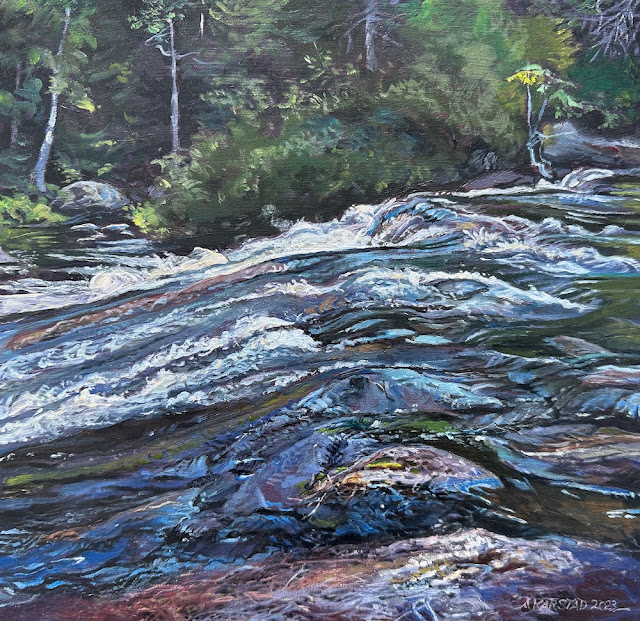View from Beausejour (oil on canvas 5 x 7 in.)
oil on canvas 5 x 7 in. $275
30 September finds us at the historic site of Fort Beausejour south east of Sackville, New Brunswick, looking out from the rolling grass knolls of the fort, over the Tantamar Marshes to the misty reach of the Cumberland Basin.
Saltmarsh ponds glint in the sun along the shoreline and beyond its sharp edge the seawater is pink with red mud - I think it becomes even pinker with the receding tide.
A red-rutted track runs between the sloped grassy lawn of the fort and a field of lush long grass, crouched in by large round bales of hay, and beyond that field the land drops away again to flat scrubby variegated fields that may have been farmed at one time, dyked and drained, now threaded through by dark lines and dashes of brushy ditches and gullies. In the distance a small herd of scattered cattle are mere dark dots, but the breeze brings me a faint bovine bellow. It is very quiet up here at the top of the world, until a train clatters along the tracks that were barely visible beyond the edge of the field.
Fred has returned from his walk along the rail line to scan the marshes for the puffy domes of Phragmites stands. He didn't see any. This is the one place in the Maritimes where the invasive European Phragmites australis subspecies australis has been reported, so we are interested in seeing how conditions here compare to what we'd observed elsewhere in New Brunswick and Nova Scotia. Watching the traffic on TransCanada Hwy 2 beetling along to the north we figure that the place that would be most informative would be the roadsides, since traffic and earth-moving machinery are the vectors of the spread of the invasive kind.
Fred reported later: "When the painting was done, we drove the busy road across the marshes both ways, waypointing stands and taking representative specimens (and giving the artist plenty of time to reflect on the prospects that might be opened up by widowhood as she watched me crossing between long strings of very fast traffic).
30 September finds us at the historic site of Fort Beausejour south east of Sackville, New Brunswick, looking out from the rolling grass knolls of the fort, over the Tantamar Marshes to the misty reach of the Cumberland Basin.
Saltmarsh ponds glint in the sun along the shoreline and beyond its sharp edge the seawater is pink with red mud - I think it becomes even pinker with the receding tide.
A red-rutted track runs between the sloped grassy lawn of the fort and a field of lush long grass, crouched in by large round bales of hay, and beyond that field the land drops away again to flat scrubby variegated fields that may have been farmed at one time, dyked and drained, now threaded through by dark lines and dashes of brushy ditches and gullies. In the distance a small herd of scattered cattle are mere dark dots, but the breeze brings me a faint bovine bellow. It is very quiet up here at the top of the world, until a train clatters along the tracks that were barely visible beyond the edge of the field.
Fred has returned from his walk along the rail line to scan the marshes for the puffy domes of Phragmites stands. He didn't see any. This is the one place in the Maritimes where the invasive European Phragmites australis subspecies australis has been reported, so we are interested in seeing how conditions here compare to what we'd observed elsewhere in New Brunswick and Nova Scotia. Watching the traffic on TransCanada Hwy 2 beetling along to the north we figure that the place that would be most informative would be the roadsides, since traffic and earth-moving machinery are the vectors of the spread of the invasive kind.
"The first thing we noticed was that the stands were very distinctly divided into native-like and invasive-like kinds: we counted 11 alien and 7 native stands, and only 1 that we called ambiguous, though the natives graded out into little whisps, and we doubtless missed some of these which an observer on foot could have waypointed. The most striking feature of this difference was the persistent green foliage of the aliens, in contrast to the shriveled get-ready-for-winter brown of the natives (one often sees that alien plants from NW Europe retain green leaves far longer than native plants do).
"Those on NatureNS will remember that throughout Nova Scotia we were perplexed by the intermediacy and confusing morphology of the majority of the Phragmites stands we sampled there: at Tantramar there was no ambiguity, and the natives didn't look much different from the ones we see in Ontario".




Comments
Post a Comment
What do you think of this painting, and what do you know about the subject that I have painted?